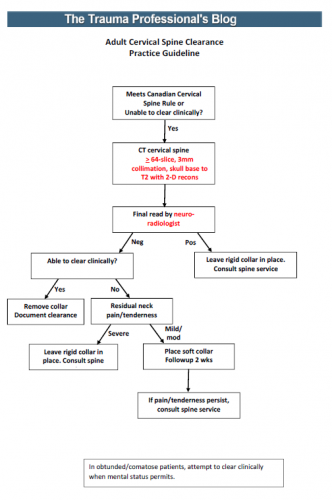More and more often, I am receiving trauma activation patients after blunt trauma with no cervical collar in place. Up until a year ago or so, literally everyone with even a hint of blunt trauma had one in place. Now, it is becoming a rarity. It seems that there has been a shift in the philosophy and practice of prehospital providers and the guidelines they follow.
The group at SUNY Stony Brook reviewed their experience with prehospital spine clearance (meaning non-placement of a collar by EMS) over a 6 year period. They analyzed trends in prehospital spine immobilization during this period.
Here are the factoids:
- Over 5,000 patients were analyzed, and the incidence of cervical spine injury remained constant at 9% over the study period
- Placement of prehospital cervical immobilization decreased from 54% to 35%
- The incidence of spine injury in patients without immobilization increased from 4% to 6%
- Of those without immobilization, 15% had a major spine injury (AIS > 3), and 19% had multisystem injuries
- Factors significantly associated with “inappropriate” prehospital clearance included fall mechanism, elderly, functional dependence, dementia, and presence of comorbidities
Bottom line: This study is intriguing, but I worry that the study population is a bit too small to draw the best conclusions. I say this because the incidence of cervical injury is significantly higher in this study that in a larger one with 34,000 patients. This may indicate either a small sample size or some type of sample bias. I’m unclear about what data the prehospital agencies used to relax the immobilization criteria, and whether or not the criteria are being applied appropriately. It does appear, however, that the elderly are at higher risk for having an injury and not being immobilized.
Here are some questions for the authors to consider before their presentation:
- How did you define cervical injury, and why is the incidence in your study so much higher?
- Do the prehospital agencies delivering patients to your center utilize the same clearance guidelines?
- Big picture question: What should we do to make sure that cervical immobilization is applied appropriately?
Reference: EAST 2018 Podium abstract #34.

